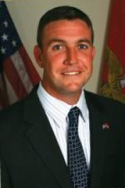

“It simply is not prudent to introduce new projects into an area that is already prone to wildfire and will also reduce the ability of fire fighting agencies…”—Congressman Duncan Hunter, on impacts of the proposed Tule wind energy and Sunrise Powerlink transmission line projects
“Sempra’s track record does not show that it will develop or manage the Baja California wind energy resources properly.” – Congressman Bob Filner
By Miriam Raftery
February 14, 2010 (San Diego’s East County) – Congressman Duncan Hunter (R-Alpine), Congressman Bob Filner (D-San Diego) have sent letters to federal and state regulatory agencies voicing serious concerns over several major energy projects proposed in East County.
Hunter called the proposed Tule wind energy project “irresponsible,” noting that the $400 million project proposed by Sempra Energy would include payment of 30% in federal stimulus funds to Iberdrola Renewables, a Spanish corporation. “If approved, American taxpayer dollars that were to be specifically utilized for the creation of American jobs will instead be used to provide opportunities to a foreign-owned company to invest and build energy infrastructure that it will then use to charge and profit off of American customers,” Hunter wrote in a February 11, 2010 letter to Michael Peevey, president of the California Public Utilities Commission (CPUC) and to Thomas Zale, project manager of the El Centro field office for the U.S. Bureau of Land Management.
Besides cost, Hunter objected to closure of public lands from the Tule wind energy project and Sunrise Powerlink, the high-voltage powerlines that SDG&E aims to run through vast tracts of East County. Hunter said the Tule Wind project would require 15,000 acres of public lands. Sunrise Powerlink would impact public lands including McCain Valley National Land and Wildlife Conservation Area, Cleveland National Forest, Lake Jennings, Lake Canyon OHV Park, Cottonwood Campground, and various parks/trails in El Monte Valley. “This represents thousands of acres in East San Diego County that are significantly utilized by my constituents no longer being accessible, appealing, or safe for a wide variety of recreational uses.”
He also cited increased threat of wildfires from malfunctioning wind turbines, substations, underground vaults, and related infrastructure in a region that has already suffered massive wildfire devastation twice in six years. “It simply is not prudent to introduce new projects into an area that is already prone to wildfire and will also reduce the ability of fire fighting agencies and other first responder emergency personnel to perform their responsibilities,” Hunter wrote. He also cited concerns that the two projects would raise property insurance rates to homeowners facing increased fire danger and risks of property damage from “self-destructing turbines and new power lines and substations.”
Hunter said studies indicate that potential exists to generate 5,000 megawatts of energy through solar by utilizing San Diego roof tops and parking lots. Such alternatives could “keep our community safe and pristine” and preserve the rural character of backcountry areas, he noted, adding that Southern California Edison has recently approved large rooftop solar projects. Hunter suggested that rooftops on military bases, colleges, universities and hospitals should be utilized locally for solar energy production. He also called for increased use of nuclear fission and fusion production for the future.
Bill Powers, an engineer with 25 years of experience in energy and environmental fields, confirmed in a letter to the CPUC that distributed photovoltaic solar is “a more cost-efficient renewable energy resource than East County wind.” He includes detailed charts from a study by Black & Veatch, an engineering contractor, which concluded that San Diego could produce 2,600 MW of distributed commercial-scale solar PV through ground-mounted and rooftop solar within SDG&E’s service territory. That does not include parking lot PV potential, which could add another 1,800 MW. He urged that an EIR/EIS identify rooftop/distributed PV as “the preferred renewable energy resource” for meeting California’s renewable energy goals.
Congressman Bob Filner, in a letter sent to Secretary of Energy Steven Chu at the U.S. Department of Energy on November 6, urged the agency to reject Sempra’s request for a presidential permit to build a cross-border 500 kV transmission line from Mexico to the U.S. The line, along with a proposed Sierra Juarez wind energy project in Baja, Mexico, would connect with SDG&E’s existing Southwest Powerlink. Since Sempra has no export wind contracts, Filner noted, if approved, the cross-border line “would likely result in the approval of the ECO sub-station at Jacumba” by the CPUC and reward SDG&E with “a $270 million windfall at ratepayer expense even if no single export turbine is ever built.”
Moreover, if the plan to import wind energy from Baja to the ECO substation goes through, it would fill the Southwest Powerlink and require construction of Sunrise Powerlink – with no assurance that the line would carry any renewable energy, Filner observed. Morever, he concluded, “Sempra’s track record does not show that it will develop or manage the Baja California wind energy resources properly.”
He called some Sempra arguments “misleading” and noted, “Sempra has a history of exploiting the Baja California assets for inappropriate financial gain.” He cited Sempra’s settlement of a price-fixing lawsuit over natural gas prices in 2006 and a court order for Sempra to pay the state of California $70 million for violating terms of a 10-year power supply contract the same year.
The County of San Diego has also voiced concerns over the projects' potential impacts on East County communities.
Descriptions of the proposed new wind and transmission energy projects for East County can be viewed here: http://www.cpuc.ca.gov/environment/info/dudek/ECOSUB/ECOSUB.htm
For SDG&E’s arguments in favor of Powerlink, click here: http://www.sdge.com/sunrisepowerlink/ . For SDG&E’s arguments for the ECO Substation, see: http://www.sdge.com/aboutus/eco/index.shtml .
Correction: an earlier version of this story incorrectly attributed Powers' comments to another party. We regret the error.










Recent comments